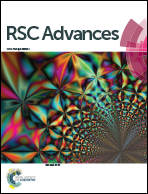Ceramide increases free volume voids in DPPC membranes†
Abstract
Positron annihilation lifetime spectroscopy (PALS) can measure changes in local free volume voids in lipid bilayers. PALS has been applied, together with differential scanning calorimetry (DSC) and molecular dynamics (MD) simulations, to study free volume voids in DPPC and DPPC : ceramide (85 : 15 mol : mol) model membranes in the 20–60 °C range. The free volume void average size clearly increases with the gel–fluid phase transition of the lipid, or lipid mixture. Ceramide increases void size at all temperatures, particularly in the range causing the gel–fluid transition of the mixture. A parallel study of PALS and calorimetric data indicates that, for the complex thermotropic transition of the DPPC–ceramide mixture, PALS is detecting the transition of the DPPC component, while calorimetry changes indicate mainly the melting of the ceramide-enriched domains. Molecular dynamics calculations provide a clear distinction between ceramide-rich and poor domains, and show that the voids are predominantly located near the membrane nodal plane. The ceramide-induced increase in void volume size occurs as well at temperatures when both phospholipid and ceramide are in the fluid state, indicating that the effect is not the result of phospholipid–ceramide domain coexistence. The above observations may be related to hitherto unexplained properties of ceramide, such as the increase in membrane permeability, and the induction of transmembrane (flip-flop) lipid motion.


 Please wait while we load your content...
Please wait while we load your content...